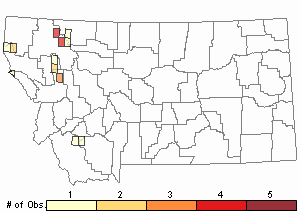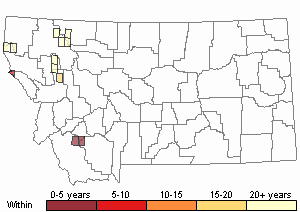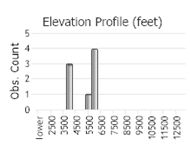View in other NatureServe Network Field Guides
NatureServe
Montana
Utah
Wyoming
Idaho
Wisconsin
British Columbia
South Carolina
Yukon
California
New York
A Rhizomnium Moss - Rhizomnium nudum
General Description
Plant: Loose tufts. Dark green with red-brown stems. Stems erect, simple, 1-5 cm tall. Rhizoids mostly at the base of stem.
Leaf: When dry, slightly contorted. Leaves obovate to somewhat orbicular, 4-9 x 3-7 mm. Apex rounded or rarely with a short apiculus. Costa red, broad at base, and narrowing toward apex. Costa usually ends before apex.
Leaf Cells: Median laminal cells more-or-less hexagonal or a little elongate in oblique rows. Median cells near costa are 70-170 x 50-70 µm, typically 120-130 µm long, and becoming shorter towards margin (30-60 µm long). In surface (transverse) view the laminal cell walls appear evenly thick and not pitted. However, in X-S view the horizontal cell walls are thin and the vertical cell walls are thick dorsally and ventrally and thin in between. Marginal cells are long and narrow, in 1-2 rows near apex, and 2-3(4) rows below apex. In X-S the marginal cells of the apex are of 1-layer and of 2-4 layers below the apex. The marginal cell walls are thick and pitted in X-S.
Seta/Capsule: Seta is 1-2.5 cm tall and red-brown. Capsules are inclined to pendant, yellow-brown, ovoid, rounded to seta, neck hardly differentiated, 2.5-3.5 long, and irregularly wrinkled when dry.
Diagnostic Characteristics
This species differs from Rhizomnium species by its naked stem, leaves hardly contorted when dry, the unusual cell walls in X-S, and the short operculum. All Rhizomnium species lack marginal teeth while Plagiomnium species have single-toothed margins and Mnium species have double-toothed margins.
Range Comments
Amphiberingian distribution. Russian Far East, Japan, Alaska, British Columbia, Alberta, Washington, Idaho, Montana, Oregon. (Records from northern California reportedly based on misidentifications.) In Montana, known from Flathead, Glacier, Lake, Lincoln, and Sanders Counties (Elliott 2016).
Observations in Montana Natural Heritage Program Database
Number of Observations: 22
(Click on the following maps and charts to see full sized version)
Map Help and Descriptions
Relative Density

Recency



 (Observations spanning multiple months or years are excluded from time charts)
(Observations spanning multiple months or years are excluded from time charts)
Habitat
On moist soil in the woods and along streams. Lowlands to about 6,600 feet elevation.
Reproductive Characteristics
Dioicous. Seta is 1-2.5 cm tall and red-brown. Capsules are inclined to pendant, yellow-brown, ovoid, rounded to seta, neck hardly differentiated, 2.5-3.5 long, and irregularly wrinkled when dry.
Stewardship Responsibility
References
- Literature Cited AboveLegend:
 View Online Publication
View Online Publication Elliott, J.C. and A.K. Pipp. 2018. A Checklist of Montana Mosses (1880-2018). Updated 3 January, 2020. Montana Natural Heritage Program, Helena, Montana. 73 pp.
Elliott, J.C. and A.K. Pipp. 2018. A Checklist of Montana Mosses (1880-2018). Updated 3 January, 2020. Montana Natural Heritage Program, Helena, Montana. 73 pp.
- Additional ReferencesLegend:
 View Online Publication
View Online Publication
Do you know of a citation we're missing? Elliot, J. C. 1993. Second checklist of Montana mosses. Unpublished report. U.S. Forest Service, Region 1. Missoula, MT. 45 pp.
Elliot, J. C. 1993. Second checklist of Montana mosses. Unpublished report. U.S. Forest Service, Region 1. Missoula, MT. 45 pp. Lawton, E. 1971. Keys for the Identification of the Mosses on the Pacific Northwest. Reprinted from 'Moss Flora of the Pacific Northwest'. Published as Supplement No. 2 of the Journal of the Hattori Botanical Laboratory. Nichinan, Miyazaki, Japan. 66 pp.
Lawton, E. 1971. Keys for the Identification of the Mosses on the Pacific Northwest. Reprinted from 'Moss Flora of the Pacific Northwest'. Published as Supplement No. 2 of the Journal of the Hattori Botanical Laboratory. Nichinan, Miyazaki, Japan. 66 pp. Lawton, E. 1971. Moss Flora of the Pacific Northwest. Hattori Botanical Laboratory. Japan: Yamabuki-cho, Shinjuku-ku, Tokyo. 362 pages plus appendices.
Lawton, E. 1971. Moss Flora of the Pacific Northwest. Hattori Botanical Laboratory. Japan: Yamabuki-cho, Shinjuku-ku, Tokyo. 362 pages plus appendices.
- Web Search Engines for Articles on "A Rhizomnium Moss"





